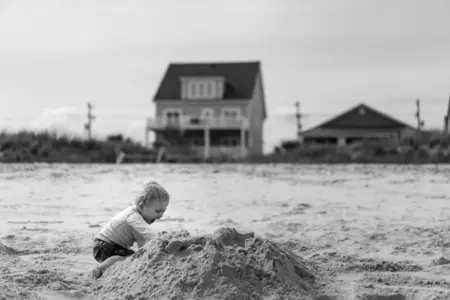
You have already bought your bag of play sand, and you can’t wait to add it to your tank. You are probably wondering how you will clean the play sand for aquarium use. Well, it is your lucky day!
In this article, I will go into great detail on cleaning play sand properly and more. I will try to simplify the process as much as possible while making the process very efficient. Let’s go!
Cleaning play sand
Play sand is very cheap and affordable for most of us. The price tag is attractive, but the quality we get is deserving of the price.
It is very dusty and may even have large chunks of foreign objects in them. Your cleaning process should be based on addressing stuff like this.
Without wasting more space and time, here is how to clean your play sand properly:
Sifting
The first thing that we are going to take out is the chunks of foreign objects and debris. You will need a 5-gallon bucket, sieve, filter/ net, and something you can scoop the sand with.
Add sand into the bucket through the sieve. You can shake the sieve gently to release the finer particles through faster. You should add enough sand to fill the bucket halfway.
If you’re using a finely netted material or clothing, tie it around the opening of the bucket and fill your bucket with sand. This is a faster, more efficient way of sifting sand.
Rinsing
Your bucket of sand is now half-filled, great. We can now do the actual cleaning; cue in your rinsing skills. You will need a pressure hose and two or more spare buckets. I will tell you why soon.
Tilt the bucket such that the sand is one or two inches from the opening. Use the hose to add pressured water into the bucket. If your water is pressured enough, you don’t have to stir the mixture. The pressure of the water will naturally ‘beat’ light objects.
The lighter particles will float and make the water cloudy; let this water run. Keep adding water into the bucket until you notice the water run clear. You can stir the water for the added measure, but once the water is clear, you’re good to go.
You might have to repeat this a couple of times with each round of sand buckets. Depending on the quality of your sand, one round of rinsing would take you about 5 to ten minutes.
After your sand is clean enough, transfer it into the spare buckets and repeat the process of sifting. You will go through the process repeatedly until you have the amount of clean sand you need for your tank.
The aim of rinsing sand is to eliminate dust. Little to no dust must enter your tank. The dust will make your water cloudy. Furthermore, it can stress fish not used to muddy or murky water.
Sterilizing
After you have the right amount of sand cleaned, we are going to sterilize it. Disinfecting sand is down to whether or not you trust the sand you have. Play sand may contain harmful bacteria that will not only hurt your fish but also interfere with the balance in your fish tank (if cycled already).
It is thus scientifically logical to sterilize play sand before introducing it into the tank. There are two ways of fixing sand, and they both involve hot water.
You can either directly simmer the sand in the water while heating or add boiling water into the bucket of sand and let it soak for six or more hours.
If you go with simmering, heat the mixture of water and sand until the water starts boiling. You can then reduce the heat just enough to keep hot water going. Fifteen minutes are enough for simmering.
For the latter, soak the sand in hot water with occasional water replacement to keep it hot. Lately, there have been concerns that hot water will draw toxic chemicals from the inner walls of plastic buckets. Since that makes some sense, you can go with the first method or replace the bucket with something less plastic!
Adding sand into your fish tank
I think you should do this before other components of the aquarium are placed in the tank. If you are setting up the tank, then your work got a whole lot easier.
All you have to do is first add the layer of sand in your tank- about 1 to 1.5 inches deep, depending on the size of your tank. After placing the substrate, place a plate or nylon paper above and add water gently. This way, you can avoid making your water murky/cloudy.
Aquarists with already set up tanks will have to take out all the tank inhabitants temporarily. Adding sand into such a tank will have the water cloudy for some time. You should let the sand settle a bit before putting the inhabitants back.
You can, of course, add the sand directly without taking anything out. The water will probably be cloudy for a while though carbon filters can take care of that much faster. You should, however, be careful not to add cold sand into a tank with fish—hard sand due to the rinsing you did with low-temperature water. The sudden drop in temperature will kill your fish!
Why I prefer pool filter sand to play sand
Any fishkeeper you ask will tell you that pool filter sand is the better option of the two. It needs less cleaning and is of good quality.
Play sand will be more compact with time, while pool sand will allow water to flow through due to its uniform granules. It is slightly higher than play sand, but it is worth spending a couple more bucks on.
Moreover, you can always go ahead and add it directly into the aquarium with this simple trick. I found the video sometime back and could not help but grin at how simple this process is. I am sure you will think the same.
Conclusion
When cleaning play sand, you are essentially taking out dust and debris. The whole process of cleaning is geared to do this.
It can be long, frustrating, and tiresome, I know. It is the same for all of us. We still do it for our fish’s sake. It is our responsibility, after all, to give them the best we can.

Jesse is the principal author of this blog. He is an avid fishkeeper with rich experience spanning several years. He is here to share his knowledge and ensure you also have a guiding compass, as he did with his father.